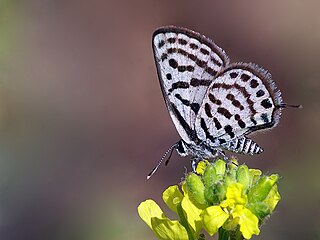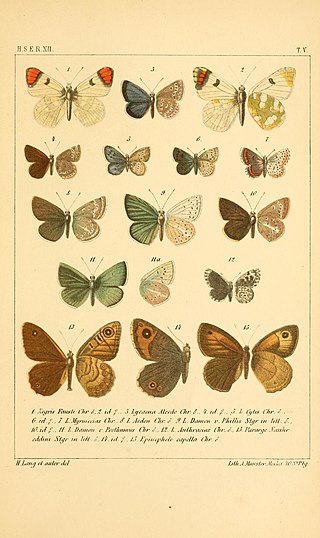
Lycaena phlaeas, the small copper, American copper, or common copper, is a butterfly of the Lycaenids or gossamer-winged butterfly family. According to Guppy and Shepard (2001), its specific name phlaeas is said to be derived either from the Greek φλέγω (phlégo), "to burn up", or from the Latin floreo, "to flourish".

The dark green fritillary is a species of butterfly in the family Nymphalidae. The insect has a wide range in the Palearctic realm - Europe, Morocco, Iran, Siberia, Central Asia, China, Korea, and Japan.

Parnassius delphius, the banded Apollo, is a high-altitude butterfly which is found in Central Asia. It is a member of the genus Parnassius of the swallowtail family, Papilionidae.

Parnassius actius, also known as the scarce red apollo, is a high-altitude butterfly found in Central Asia. It is a member of the snow Apollo genus (Parnassius) of the swallowtail family (Papilionidae).

Lycaena thetis, the golden copper, is a small butterfly found in Greece, Asia Minor - Armenia (highlands), Iraq, Iran, Baluchistan, Chitral and Ladak that belongs to the lycaenids or blues family.

Pontia callidice, the lofty Bath white or peak white, is a small butterfly of the yellows and whites family (Pieridae), which occurs in the Palearctic realm.

Poritia erycinoides, the blue gem, is a small butterfly found in India, Myanmar and parts of South-East Asia that belongs to the lycaenids or blues family.
Plebejus christophi, the small jewel blue, is a small butterfly found in Asia that belongs to the lycaenids or blues family.

Tarucus balkanicus, the Balkan Pierrot or little tiger blue, is a small butterfly that belongs to the lycaenids or blues family. It is found in Mauritania, Niger, Sudan (Khartoum), Uganda, Saudi Arabia, the United Arab Emirates, Oman, North Africa, the Balkans, western Asia, parts of central Asia and in India. The habitat consists of very arid savanna.

Polyommatus eros, the Eros blue or common meadow blue, is a species of blue butterfly found in the Palearctic.

Pamiria omphisa, the dusky green underwing, is a species of blue (Lycaenidae) butterfly found in Asia.

Plebejus is a genus of butterflies in the family Lycaenidae. Its species are found in the Palearctic and Nearctic realms.

Pseudophilotes baton, the baton blue, is a butterfly of the family Lycaenidae. It is found in central and southern Europe and then east across the Palearctic to the Russian Far East.

Turanana is a genus of butterflies in the family Lycaenidae. It is found in the east Palearctic from Greece to Central Asia.

Chazara briseis, the hermit, is a butterfly species belonging to the family Nymphalidae. It can be found in North Africa, southern Europe, Asia Minor, the Caucasus, Kazakhstan, Central Asia through Afghanistan, and north-western China and Tuva. It is found on steppe and in other dry grassy places between 500 and 2,500 meters.

Aulocera padma, the great satyr, is a brown (Satyrinae) butterfly that ranges across the Himalayas to Assam, northern Burma and western China.

Melitaea arduinna, or Freyer's fritillary, is a butterfly of the family Nymphalidae. It is found from south-eastern Europe across Asia Minor to central Asia and the Altai. The habitat consists of steppe-clad slopes.

Colias thisoa is a butterfly in the family Pieridae. It is found in the mountains of the Caucasus, Transcaucasia, central Asia, southern Siberia, Turkey and Iran. The habitat consists of humid mountain meadows in the forest belt.

Pieris krueperi, the Krueper's small white, is a butterfly in the family Pieridae. It is found on the Balkan Peninsula and in Iran, Baluchistan, the Kopet-Dagh and from Asia Minor to Central Asia, as well as in Oman. The habitat consists arid areas with scanty vegetation up to 2,500 metres (8,200 ft) in the mountains.

Gonepteryx farinosa , the Powdered Brimstone, is a butterfly found in the Palearctic that belongs to the whites family.




















